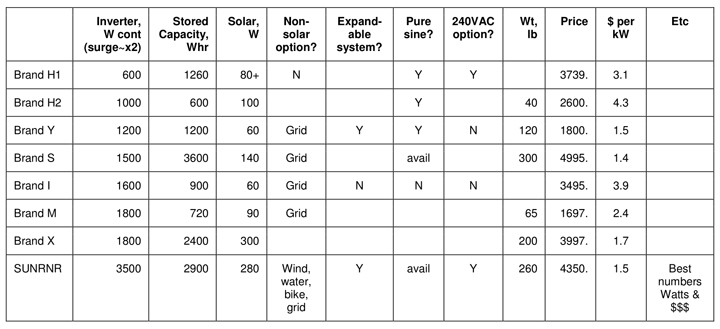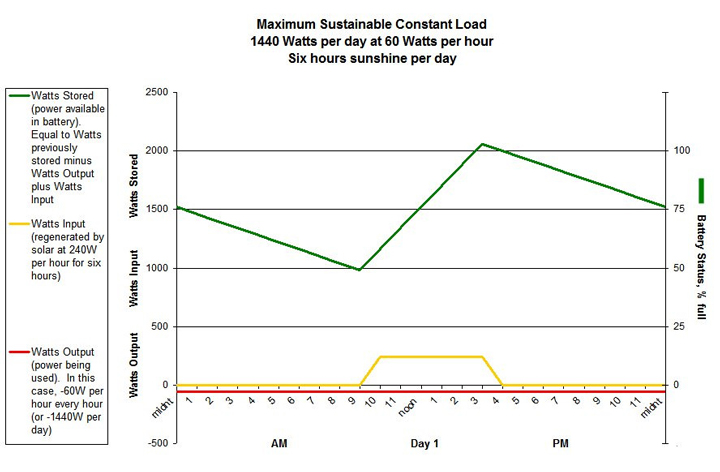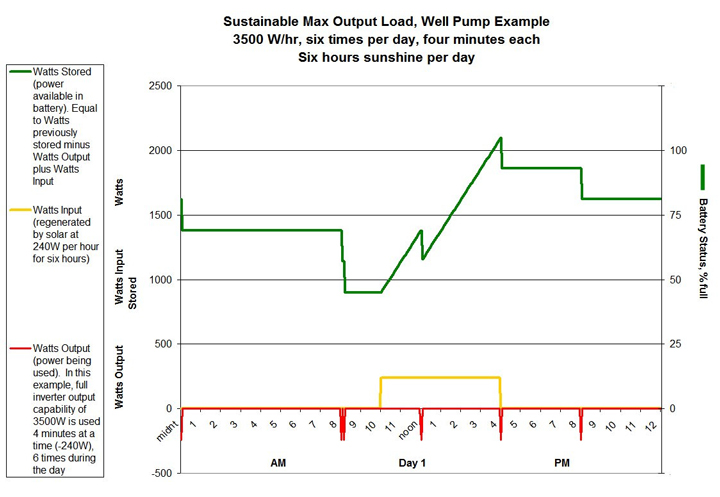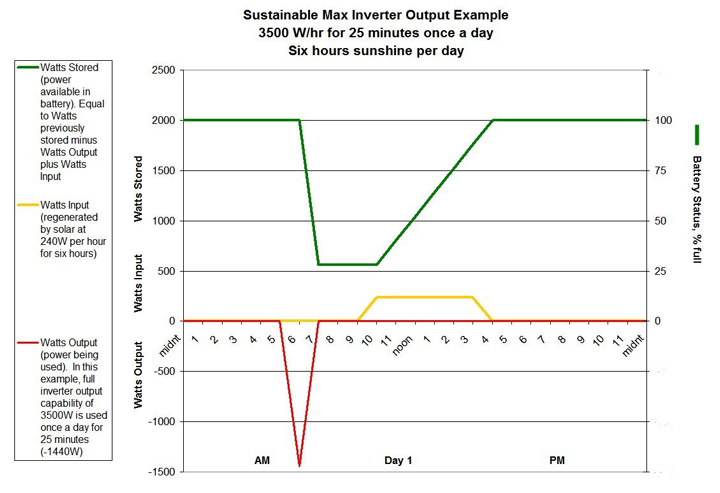It is important to pay attention to product specifications regarding the rate at which energy is coming in, the amount of energy stored, and the rate at which that energy is being consumed.
Jenny French | SUNRNR
When choosing any piece of equipment, many variables come into play. When that piece of equipment is a generator or power supply system, the variables may include size, output power, noise, energy source, and endurance. Defining the equipment’s application (its purpose and how you plan to use it) can be helpful in defining those variables, thus simplifying the choices.
Power generation systems have hundreds of applications. This article will focus on portable generators in specific and a range of their applications and sizing considerations in general. The intent is to address the frequently-asked questions, “What will this generator run?”, “For how long?”, and “Will it run my house?” Those questions usually have to be answered with the question, “What do you want (need) to run?” which defines the application.
To start, some basic electricity concepts are required. First off, Watts equals Volts times Amps (W = V x A). Watts (1000 Watts = 1 kiloWatt) is the power required by a device and is basically related to endurance. This equation is true whether working with Alternating Current (AC) or Direct Current (DC) voltage. If AC, typical voltage numbers are 110-120V or 220-240V at 60 Hz in the US and 220-240V at 50 Hz internationally. If working with DC voltage, 12 and 24 VDC are common. Amps are device-specific and relate to the electrical load required to run a device. Some devices require an initially higher start up surge before running at their continuous load.
And beware, there is an inherent time unit (almost always “hours”) on both sides of the W = V x A equation, sometimes stated, sometimes not, sometimes appearing in the numerator (i.e. Watt-hour and amp-hour), but often inferred in the denominator as Watts or amps per hour. If a device specifications sheet, data plate, or owner’s manual says 1000 Watts, it means that device’s power consumption will be 1000 Watts to run continuously for one hour at its highest power setting.
Your coffee maker might be such a 1000 W device. However, it is only using 1000 W during the time it is brewing and possibly only 200 W after with the hot plate on. If it brews for six minutes and warms for 54 more before shutting off, you have used 1000(0.1)+200(0.9) or 280 W. Later, to reheat a cup in your 1000 W microwave for 1.5 minutes on high, you use another 1000(1.5/60) or 25 W. A refrigerator might be rated 6 amps (660W), but that would be with the door open, defrost on, and running the ice maker. However, average hourly power consumption of the same refrigerator under normal use (average chilling cycling of the compressor) may be under 100 W. A working rule of thumb for variable power devices is 20% or 1/5 th of the stated maximum power consumption.
After we know what we want to run and for how long, we can choose a generator capable of providing that power. The generator’s power output is limited by any combination of the inverter, circuit breaker, fuse, or plug receptacle amp limit. A generator’s rating will be defined by its outlet limitations and/or its inverter’s surge and continuous power capability. Typical wall outlets in a house powered by the grid are protected to 15 amps. Therefore, to be sure the generator’s inverter can run common household appliances, it must be rated for 1800W or greater (120V x 15A = 1800W). For example, an 1800W inverter will likely have two 15amp receptacles. One outlet could run a high-amp appliance such as a large 1500W microwave while the other outlet would then be limited to a very short surge load or a low, continuous load like a couple of light bulbs. Of course, both outlets could also be used simultaneously with low to medium amp load appliances. The advantage of an inverter with a higher rating such as 3500W and having four receptacles is the ability to run four devices (or more using power strip) at one time with very little chance of overloading/faulting the inverter, needing to plug/unplug devices, having to stagger usage, or be limited to only one high-load appliance.
Gas generators are generally labeled by this power output number and their specs (endurance, fuel usage) are often given with respect to a percentage of maximum. Low-Watt gas generators will run lower-Watt devices at low power at a relatively low decibel level and for a relatively long time per fuel fill-up. Industrial, higher-Watt gas generators are able to run air conditioners, large power tools, etc while louder and requiring more fuel. However, since one of the applications of generators is to provide power during an outage and because fossil fuel may not be available during an outage (either no electricity to run fuel pump or high consumer demand), alternative energy generators are becoming popular. No matter what fuel source a generator uses, budgeting of the usage (output) and of the “fuel” (input) is required, whether the fuel is measured in gallons or in hours of sunlight/wind.
When comparing renewable energy generators, some basic functionality (application, design, location) questions should be answered to help choose your make/model and determine the three important energy specification requirements - input, storage, and output.
- What are your portability requirements or weight limitations? Hand-carried, wheeled unit, use in pickup truck, …?
- What source of energy generation do you wish to use? Solar, wind, kinetic (bicycle), water, grid, …?
- If solar, where will panels be located? Attached to or separated from generator unit? Mounted?
- What is the voltage of the equipment to be powered? (110V/60Hz, 220V/50Hz, 240V/60Hz, or 12VDC)
- What is the maximum amperage (or Wattage) of any of the equipment to be powered?
- Is your primary goal solar backup or do you want to use the generator as constant additional power?
- Duration/endurance/time is essentially a function of battery capacity, usage, and recharge rate.
A few more basic electricity concepts are helpful in furthering this discussion toward portable solar generator product comparisons:
- Energy input from photovoltaics (solar PV) can range from tiny 10 W solar-powered calculators to small 60 W foldable solar sheets to larger 200 W stand-alone panels to >1000 W panel arrays.
- Energy storage capacity in a rechargeable battery often ranges from 50 to 400 amp-hrs using lead acid absorbed glass mat technology. Current battery technology is in desperate need of innovative breakthroughs, but for now, the more a battery stores, the more it weighs. Capacity in amp-hrs is multiplied by battery voltage (i.e. 12 VDC) to get battery storage in Watt-hrs.
- Energy output through a DC-to-AC inverter is measured in Watts and may be 200-5000 continuous with short- term surge being about twice that.
In other words, it is important to pay attention to product specifications regarding the rate at which energy is coming in, the amount of energy stored, and the rate at which that energy is being consumed. Budgeting the generator’s stored energy is similar to maintaining a bank account balance or a vehicle’s gas tank level – you can only take out what you’ve put in. Before choosing a renewable energy generator, researching and filling out a table similar to the one below may be useful.

Other options, characteristics, specifications, cautions to consider (Etc column):
- Number/amp limit of receptacles. Lower-rated inverters have fewer outlets. Power strips for expansion are acceptable, but the load on any one receptacle must stay under its amp limit and the total load (all used receptacles combined) must stay under continuous/surge limits to avoid automatic shutdown.
- Is 12VDC output available and at what amp limit? Many models have the “cigarette-lighter” socket available, but with a special auxiliary plug, a SUNRNR can provide 12VDC at 30 amps.
- Modified sine wave inverters are most common, least expensive, and work perfectly for most equipment. However, certain equipment such as high-end audio/video or water makers may require a pure sine wave option.
- Distance desired between unit and panels (some are combined and inseparable). Cabled panels are often preferred since where the sun is shining may not be the same place where power is required.
- Country of manufacture - Chinese or American?
- Electricity should always be treated with respect. A plug and play system in a steel enclosure providing no access to the “pointy end” (battery, wiring) is safer compared to a kit, a non-steel/plastic enclosure, or a batteries- sold-separately unit.
Using data from the table above, here are several examples of “What will it run?” and “How long?”:
- Without recharging, a 50 W (average) EnergyStar refrigerator, 44 W ceiling fan (low speed), and 2 “60W” 3 W LED lights (100W total load) would run about 6 hours with Brand M, 10 hours using Brands H1 and Y, and 20+ hours using Brand S, X, or a SUNRNR. Now if 6 hours of sunlight each day was available, a SUNRNR could run almost the same load EVERY day, i.e. “sustainable”. See Constant Load Chart below.
- One brand above is best known due to their extensive advertising campaign, but when you do the math for daily usage as a solar backup, it only offers 350 Watts per day (i.e. a fridge, fan, and lights for 3 hours out of a day). The chart below shows a SUNRNR can provide four times that amount on a continuous basis.
- Again, without recharging, a 1200 W chainsaw could run continuously for half an hour with Brand M, one hour with Brand X, two hours using a SUNRNR, and would most likely fault the inverter of Brands H1, H2, and Y.
- If the appliance to be run required the full output capability of the inverter, like a high-horsepower well pump, a recharging SUNRNR can provide that full output for about 25minutes each and every day, whether all at once or spread throughout the day. For a 20 gpm pump, that’s 500 gallons. See Max Output Charts below.
- More examples are available on www.sunrnr.com.
Lastly, “Will it run my house?” The easiest way to calculate your household electrical power consumption is to look at your monthly utility bill. It has all the information to calculate average hourly use either by month or over the past year. In 2008, the average US household consumed 920 kW/month or roughly 1300 W/hr. That means it would take 22 SUNRNR generators to run an average US house each day, every day continuously. Will a SUNRNR run my entire house? Not likely. Can I power a small cabin? Possibly. Can one or more SUNRNRs decrease my grid-usage and be available as solar backup during power outages? Absolutely! (With the added bonus of decreasing your electric bill by 5%!)
Daily/Constant Electrical Load – One SUNRNR, Two Panels, 6 hours moderate sunshine each day
The following demonstrates the sustainable constant load that may be drawn from a SUNRNR when a recharging source is available, in this case by solar. Day Two, Three, Etc would be equivalent to Day One. This chart is based on average hourly usage of 60W. Some parts of the day might require more than 60W and some less. 60 Watts per hour is equivalent to 1440 Watts per day (5% of average US household usage). Every additional SUNRNR main unit or power module increases the Watts available for constant use by 100%.

The 60W/hr average load shown here is the equivalent of running a refrigerator continuously and several hours of fans, lights, computer, TV daily.
Daily Maximum Power Output – One SUNRNR, Two Panels, 6 hours moderate sunshine each day
These charts show examples of using the full 3500W power output capability of the inverter while saving enough power to remain sustainable (each day similar to Day 1). In the first one, usage is spread throughout the day like a residential well pump providing water at varying intervals, especially in the morning. At this rate, even a small 10 gpm pump could provide 240 gallons of water. The second chart applies to an application where full output power would use all the available (and still be sustainable) stored power over a period of 25 minutes once a day.


About SUNRNR of Virginia
SUNRNR of Virginia started in the Shenandoah Valley in 2004 when Alan Mattichak realized the need and potential for a non-gasoline, alternative energy, portable generator, rechargeable battery, energy storage system with useful power available for remote location, off grid electricity for work, recreation, and supplemental power.
After years of engineering, testing, design improvements, and patenting, SUNRNR units are now available and affordable to the public. Visit our product pages for details, purchasing information, and product comparisons to see why SUNRNR is your best portable solar energy system solution.
The content & opinions in this article are the author’s and do not necessarily represent the views of AltEnergyMag
Comments (0)
This post does not have any comments. Be the first to leave a comment below.
Featured Product


